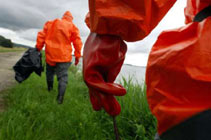Is Kelbra Lake the new Qinghai?
 Reports coming out of Germany continue to parlay bad news after bad news. It appears that a small lake in central Germany may be the most significant body of water to enter the lexicon of H5N1 trackers since China's Qinghai Lake in May, 2005.
Reports coming out of Germany continue to parlay bad news after bad news. It appears that a small lake in central Germany may be the most significant body of water to enter the lexicon of H5N1 trackers since China's Qinghai Lake in May, 2005.
That Chinese body of water spawned the most significant spread of high-path H5N1, now known as Clade 2.2, or the Qinghai strain of H5N1. This subtype has spread across Asia, Europe and now Africa. It reaches from the Ivory Coast to the Middle East, to France and Britain, to Moscow and Siberia.
Now, Qinghai H5N1 has gained a solid footing in a small (about 3 square miles) lake called Kelbra in central Germany. Formed as the result of a dam, this arfificial lake is close to a popular tourist campground. And it appears to be teeming with H5N1. More than 300 dead birds have been fished from the water and tested in the past few weeks, and the overwhelming majority are H5N1-positive.
If this is not bad enough news, now small farms in adjacent nation-state Czech Republic are experiencing problems with H5N1 in their flocks, and thousands of birds were and are being culled across Europe. France has found H5N1 in swans, and France and Germany have raised their threat levels accordingly. Egypt, of all nations, has now blocked the import of French and German poultry. And with each passing day, the body count of dead wild birds increases across the continent.
H5N1's renewed spread across Western Europe reveals it once again to be a robust, hearty and evolving pathogen. Its ability to "go underground" and smoulder, then reappear at the most unlikely times, continues to confound the world's leading experts on influenza.
Why anyone on this planet would think that H5N1 is a non-threat does not understand influenza. And that is because the people on this planet who do understand influenza have been warning us for years that this disease is incredibly crafty and resilient.
This also underscores a growing and neglected problem; namely, the lack of a reliable test on live wild birds for H5N1. The story is the same across the globe: Live wild birds test negative for H5N1, wild birds die, wild birds test positive for H5N1. Is this because we do not have sufficient numbers of birds tested? Is this because we do not have a reliable test for the presence of H5N1 in live wild birds? Are we using the wrong test on the wrong birds? Are we swabbing the "wrong end" of the birds? Are we not swabbing throats and only focusing on the cloacal (rear end) area?
Anyone who has seen the lengths researchers have to go to just to capture wild birds for testing understands the extreme difficulty in the process. Nets, snares, traps, etc. are a pain in the cloaca. No wonder the numbers tested are so low!
But test we must, because we must know if Kelbra has become the Qinghai of Europe: The new endemic source of H5N1 for an entire continent.

Reader Comments